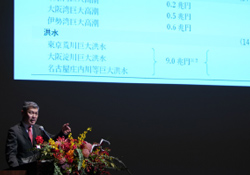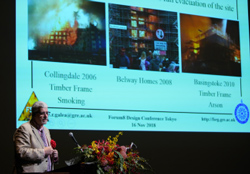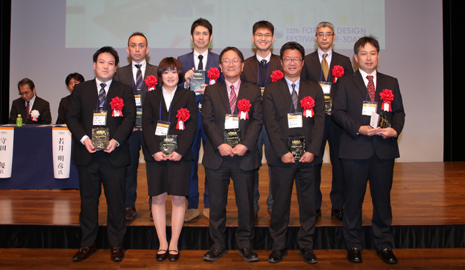| Day3 11/16 Fri. | The 12th Design Conference IM&VR i-Construction session | ||
Preparation for Catastrophic Disasters Needed, Resilience Measures and Evacuation Simulation
Design Festival Day3 (Nov. 16, 2018) started with opening remarks by Yuji Ito, Representative Corporate Executive Officer, FORUM8 Co., Ltd.
Then the special lecture was given by Professor Satoshi Fujii, Unit Manager, Resilience Research Unit, Graduate School of Engineering, Kyoto University, entitled "Damage brought by huge disasters and measures to reduce it". He gave a commentary on "Technological examination report for countermeasures against catastrophic disasters that bring about 'crisis for the nation'" released by Japan Society of Civil Engineers (JSCE) in May 2018 after a year's work over the previous fiscal year. This is what he approached JSCE to work on, from a sense of crisis that the public people are aware of almost nothing about what will actually happen when Nankai Trough earthquake occurs. First, he enumerated the examples that gigantic disasters changed nation's history: the Lisbon earthquake (1755) that was one of the reason for the decline of national power of Portugal, Bhola Cyclone (1970) that created such great turmoil in the nation as to make Bangladesh separate from Pakistan, the complex disaster of Ansei at the end of Edo period (Tokai, Nankai, and Edo earthquakes and Ansei-Edo storm in the period of 1854-1856, ) that was also a hidden cause for overthrowing of Shogunate. In his opinion, just when Japan has already lost force in its economic power as it used to have with continuous deflation and minus growth, having a large number of infrastructures such as bridges built decades ago and left deteriorated, if a catastrophic disaster occurs, Japan may become the poorest nation in Asia. Then he and others examined measures for avoiding fatal situations and limit the damage within a recoverable range when Nankai Trough earthquake, Tokyo inland earthquake, or great floods of rivers running through big cities occur. As part of this, firstly they simulated economic stagnation effect that continue for a long time (20 years for an earthquake and 14 months for a water disaster) based on the transition of Gross Regional Product (GRP) after the past occurrence catastrophic disasters such as the Great Hanshin-Awaji Earthquake (1995). At the same time, using the estimation method developed by JSCE, they estimated economic damages and asset damages caused by each of assumed catastrophic disasters. For example, the economic damage caused by Nankai Trough earthquake for 20 years amounts to at worst 1410 trillion Yen. This was 10 times greater than the estimated damage announced by Cabinet Office (170 trillion Yen as building damage), according to him. However, it is possible to mitigate 30 to 40% of the above-mentioned estimated damage if exhaustive resilience measures (e.g. civil engineering or architecture measures) are taken early. That is, investment in resilience yields even greater financial benefit in his opinion.
 |
|
The first half of the afternoon on Day3 started with the special lecture by Professor Edwin R. Galea, Director Fire Safety Engineering Group (FSEG), University of Greenwich, entitled "Engineering Safety, Security and Efficiency through Simulation". After mentioning the overview of research activities of FSEG regarding modeling safety and security, he developed topics to importance of ensuring the safety and security of crowded places. Then he talked about an agent-based evacuation simulation program of simulating what is happening in a structure, "EXODUS", and a fire simulation program, "SMARTFIRE", both of which he and others had been working on for many years.
This time in particular, he mentioned three new application areas for agent-based evacuation simulation. One of them is evacuation from high-rise construction sites, which are found at many places in big cities in the world over. Though they are in dangerous environments, there are no evacuation regulations or fire engineered evacuation solutions for them, unlike the completed buildings. Therefore, he and others analyzed the differences in traveling speeds etc. according to various situations within buildings under construction in order to establish evidences base describing human performance on construction sites. The modeling capability that also reflects unique features is expanded. The second one is construction of training environment using Augmented Reality (AR), Virtual Reality (VR), or Mixed Reality (MR) combined with game or simulation technologies. In recent years, it is questioned how to defend or react to the armed terrorists, who have shifted focus onto 'soft' targets. Prof. Galea and others started a project "AUGGMED" for automatically generating serious game scenarios to use for MR training. UNITY 3D game environment is linked with advanced simulation of EXODUS and SMARTFIRE with reinforced functions of gun shot and explosion injury. It also reacts to voice and hand gestures. As the AUGGMED training environment, three functional levels have been developed. Level 1: A trainee uses mouse and keyboard and experiences it on the display. Level 2: A trainee can obtain a sense of immersion using the head mounted display and hand controller in the VR environment. Level 3: A trainee can get a bodily sensation in the AR environment. Full mobility and advanced tactile feedback. The third application area is evacuation simulation on a city scale. While EXODUS was being expanded to applications involving large scale urban disasters through the IDIRA (Interoperability of data and procedures in large-scale multinational disaster response actions) project funded under EU FP7 (the seventh framework programme for research and technological development funded by EU), they developed evacuation simulation for wildfire and floods based on "urban EXODUS" and "web EXODUS", pedestrian-vehicle interaction models, and agent-vehicle interaction model created by linking Simulation of Urban MObility (SUMO) with EXODUS.
| This was followed by presentation of FORUM8 staff entitled "Involvement in IM&VR BIM/CIM and correspondence to i-Construction, addition, and accounting". First, he outlined links of products of IM&VR (Information Modeling and Virtual Reality) solutions with UC-win/Road as the center, efforts for promoting use of VR platform, and the lineup of driving simulator. Second, he explained the roadmap of utilization of BIM/CIM, conditions of its utilization, Guidelines of introducing CIM (draft) and Standards for 3D notation (draft), Guidelines for public works quantity calculation (draft), BIM/CIM requirement, and product support for them, using demonstration. He also introduced application cases of VR in recent years including use of data created with BIM/CIM. In addition, he mentioned new functions of UC-win/Road Ver.13.1, UAV Plug-in Option, Shade3D etc. Finally, as future development, he talked about response to the latest standard and format, extension of VR-Cloud® NEXT, development of UC-1 Design calculation on Cloud and on-site application, analysis and maintenance of big data, thoughts about proposal for utilizing IoT data and robots. |
|

 |
Announcement of Awards and Award Ceremony for The 5th National Resilience Design Award | Day3 | ||
Sensible and Original Technological Proposals Accumulated, Further Spread of Base Expected
Announcement of Awards and Award Ceremony for the 5th National Resilience Design Award (NaRDA) were held in the second half of the afternoon. This award covered the areas of structural analysis (civil engineering and construction), ground and water engineering, and disaster prevention. 9 entry works for this award had been nominated at the meeting for selecting nomination works held on Oct. 17 out of many works applied by Oct. 9. Prior to the announcement and ceremony, the final examining meeting was held at FORUM8 Tokyo head office in Nov. 13, where awards were selected. The judging committee consisted of Chief of the judging committee Hiromichi Yoshikawa, Professor Emeritus, Tokyo City University; and two judges Masaru Morita, Vice-president of Shibaura Institute of Technology, Professor of Urban Environmental Engineering Laboratory, Civil Engineering Department, Shibaura Institute of Technology; and Akihiko Wakai, Professor, Science and Engineering Department, Gunma University.
Grand Prix was won by "Applying the residual strength evaluation method using degradation level check to jetties - Proposal of a new strength evaluation method using a loading experiment and general regular check results" by Institute of Technology, PENTA-OCEAN CONSTRUCTION CO., LTD. For jetties exposed to severe environment against salt damage, this research proposes a simple residual strength evaluation method performing a loading experiment of specimens for each degradation level to reveal the relationship between the degree of degeneration and the residual strength of members and export the results to general structure analysis software programs. According to Prof. Emeritus Yoshikawa, this work was evaluated in that although mentioned as "a simple method", it is never simple but rather logical and highly versatile method, allowing analysis and judgment of the characteristics of members through experiments.
Excellent Award (Semi Grand Prix) was won by "Seismic performance evaluation according to damage on material - Proposing a reasonable shear strength evaluation method for underground structures -" by Knowledge Fusion Co.,Ltd. This work proposes a reasonable shear strength evaluation method for underground structure of sewage facilities, using a damage indicator that does not depend on the element dimension or the dynamic model of materials. According to Prof. Morita, the high degree of accuracy and perfection of this work was evaluated, because in addition to proposing a new evaluation method, this work conducted meticulous verification including experiments to show its reasonableness compared with the conventional method.
The other awards included "Judge's Special Prize: Full 3D Design Award" (KATAHIRA & ENGINEERS INC.), "Judge's Special Prize: Amenity Design Award" (Kagoshima University), and "Judge's Special Prize: Performance-based Design Award" (NIHON SAMICON C., LTD.) were announced and given by the respective judges. The ceremony was concluded by Professor Emeritus Yoshikawa, Chief of the judging committee, stating expectation for more participants next year, based on the significance of NaRDA. All sessions were finished.
|
|









